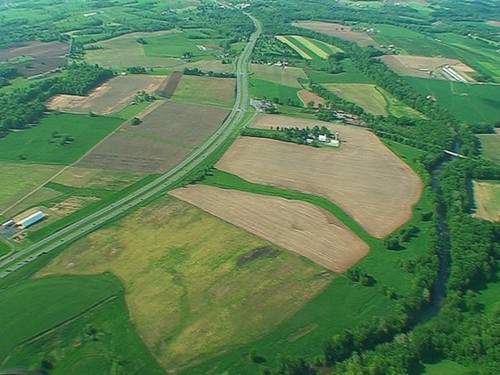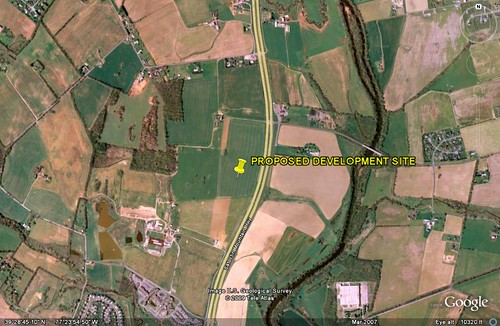Does this look like a good place for smart growth development?

Posted September 4, 2009 at 12:59PM
I don't think so, either. But the leaders of the city of Frederick, Maryland, apparently think otherwise. This is despite strong opposition from the leaders of surrounding Frederick County, which until now has had jurisdiction over the property.
Basically this is farmland clearly beyond the reach of current development (you can see the edge of current Frederick development - actually a retirement community - just inside the satellite image, at below left). The farms will soon become yet more sprawl if they are built with an office park and residential subdivision, as intended under the city's decision to annex the properties on both sides of the main highway, US Route 15.
My friend Kai Hagen, who is an elected member of the Frederick County Commission, believes that, instead of sprawl, community leaders should focus on the following principles:
- Protect the Monocacy River [visible running north-south in the right area of both images] corridor, productive farmland, scenic vistas, and a buffer between Frederick and Walkersville.
- Focus on the existing "pipeline" of future development in the city (more than 3,000 homes). Get that done first, done right, and evaluate the impact.
- Don't expand dramatically to the north when existing roads are inadequate, congested and dangerous, and there's no plan to solve that anytime soon.
- Emphasize well conceived infill and redevelopment. Don't neglect existing neighborhoods in danger of serious decline.
- Don't skirt the letter of the law by rushing to approve two major and controversial annexations within six months of the 2009 election.
 All five county commissioners signed an op-ed in the Frederick News-Post opposing the annexation of the 336 acres at issue, and the county school board has opposed current plans for a school-sprawl site on the property as well.
All five county commissioners signed an op-ed in the Frederick News-Post opposing the annexation of the 336 acres at issue, and the county school board has opposed current plans for a school-sprawl site on the property as well.
Maryland has a suite of smart growth laws, and these properties have fallen outside the development sites that must be designated in order to receive state infrastructure funding. But one of the major loopholes in the law is that, once the property becomes part of a city, it is generally deemed appropriate for development. The city's aldermen approved the annexation last night.
Challenges await, including a likely petition to overturn the decision by referendum. The county commissioners have also asked the state's planning office to weigh in regarding the property.
For the sake of Marylanders who care about their land, the health of their cities, and the environment, let's hope a challenge is successful. Until that is the case, sprawl remains alive and well in the state that coined the phrase "smart growth."

